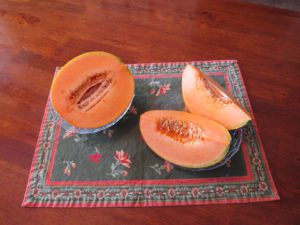Apr. 24 column: Growing melons

If it’s Sunday, that means it’s time for my next garden column. This one is all about growing melons. What? You think it’s impossible to grow them in this region? Well, I’m here to tell you that I’ve been doing it for years and it’s easy-peasy.
I have to admit I’ve given up on growing watermelons. The large ones do need a really long season to develop and ripen. The short-season varieties (such as ‘Sugar Baby’) are underwhelming, in my humble opinion.
But I do love growing cantaloupes! My go-to variety for years was ‘Alaska hybrid’ and I certainly recommend it. However, last year, I grew 2 varieties that were outstanding. They were ‘Tuscan Napoli’ (Renee’s Garden Seeds) and ‘Arava’ (Seeds of Change).
Both are short-season varieties and the flavor? Out of this world!
I hope you’ve noticed that I’ve written this column early enough so you can grow your own melons this season! Here’s a link to my column: Melons worth the extra effort. In it, you’ll learn what I do to get them off to a great start so I can enjoy plenty of melons later on. (you can also read my column below)
Let me know if you grow melons this year. Just drop me a note at Susan@susansinthegarden.com.
Growing Melons garden column:
by Susan Mulvihill
Few gardeners in this region grow melons. They’ve likely been told our season is too short and rarely see anyone else growing them, so they don’t feel compelled to try. But it is possible.
I’ve been growing cantaloupes for years and have learned what it takes to pull it off. I’m willing to give them a little extra attention because the taste of a sweet, succulent, vine-ripened melon makes it all worthwhile.
The most important step is to choose a short-season cultivar. By that I mean one that will reach maturity in less than 80 days, but preferably much sooner than that.
Examples include [variety names] Alaska hybrid (65 days), Minnesota Midget (60 to 70), Napoli (75), El Gordo (75) and Arava (70). Last year, I grew Napoli — a Tuscan cantaloupe — and Arava, which is a honeydew melon; the taste of each was out of this world so they’re on my planting list again this year.
Melons are a warm-season crop. To be on the safe side, plant them after all danger of frost is past. I start my seeds indoors two weeks before transplanting them into the garden to give them a head start.
When planting the seeds, I get better germination rates by correctly orienting them. This means planting them with the pointed end down, so the sprouting seed won’t have to spend its energy orienting itself in the correct direction. Often, the seedling will die as a result because it just doesn’t have the strength to grow at that point. Correct orientation at planting resolves this problem.
Out in the garden, I add a little bone meal to the soil in the melon bed because it’s high in phosphorus, which helps plants bloom and set fruit. I then cover the soil with a sheet of red plastic mulch, which raises the soil temperature.
I transplant the seedlings into the bed between May 15 and 21, as long as there aren’t freezing temperatures in the forecast. To plant them, I cut an “x” into the plastic mulch, dig a small hole, insert the seedling and press the soil around the root system to eliminate any air pockets. The plants should be spaced 12” to 18” apart.
The next step is particularly important:
For the first two to three weeks, I keep the plants covered with floating row cover. This product is a lightweight fabric that lets light and moisture get through but, more importantly, provides a few degrees of frost protection. Since melon plants are such heat-lovers, they really benefit from this early pampering. After that period, I remove the cover to give bees access to the flowers for pollination.
Melon plants rarely have insect or disease problems, so they’re quite easy to care for.
Once I see that small melons are developing on the vines — usually one or two per plant — I start trimming back the vines so they’ll devote their energy to growing and eventually ripening the melons. There’s no point in allowing the vines to continue flowering because there won’t be time for those melons to ripen.
My plants grow in a 3 foot by 8 foot raised bed and I usually end up with about 12 to 15 melons.
As the melons ripen, the rind lightens in color and a delightfully sweet fragrance is noticeable. Ripe melons will start pulling away from the vine.
I do hope you’ll try your hand at growing melons. The sweet reward is definitely worth it.

